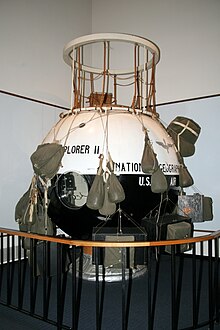Orvil A. Anderson
Orvil Arson (actually Orson ) Anderson (born May 2, 1895 in Springville , Utah , † August 23, 1965 at Maxwell Air Force Base , Alabama ) was an American Air Force officer, most recently major general , balloon pioneer and air war theorist.
Life
Anderson dropped out of Brigham Young University in 1917 to join the aviation section of the United States Army Signal Corps . He was trained as a balloon observer and received his officer's license in 1918.
In 1922 he was a co-pilot on the first transcontinental airship flight and achieved fame in the 1930s for his flights in the balloons Explorer I 1934 and Explorer II 1935, in the latter of which he and Albert William Stevens set a world record for 22 years at 72,395 feet (22,065 m) Set up balloons. For this he and Stevens were awarded the Mackay Trophy , the Harmon Trophy and the Hubbard Medal .
From 1936 to 1937 Anderson attended the Air Corps Tactical School and then the Command and General Staff School until 1938 . After brief employment on the Air Corps Board , he was appointed to the Air War Plans Division in Washington. Here he worked under Harold L. George on the formulation of the Air War Doctrine of the Army Air Forces for the Second World War , which was expressed in the directives AWPD-1 and AWPD-42 .
In 1943, after the Allied Combined Bomber Offensive began , Anderson was appointed chairman of the Combined Operational Planning Committee , which was supposed to coordinate British and American efforts. In early 1944 he also took over the post of deputy commanding general for operations of the Eighth Air Force and planned in this role, among other things, the Big Week .
After the war ended, Anderson headed the military advisory board for the United States Strategic Bombing Survey . Upon graduation, he became the first in command of Air War College at Maxwell Field in 1946 . During the war he had already written a study in which the “minimum strength of the US air force at the end of the fighting in Europe” was to be determined as a counterweight to the numerical superiority of the Soviet ground forces. As the head of Air War College, he tried to further promote these ideas of air superiority as a guarantor of US security. In 1950, shortly after the outbreak of the Korean War , he was dismissed from his post by Air Force Chief Hoyt S. Vandenberg after allegedly making careless statements to the press about the Air Force's ability to destroy the nuclear power of the Soviet Union . He then went into retirement.
Web links
- Lt. Col. John H. Scrivner, USAF (Ret.): Maj. Gen. Orvil A. Anderson , in: Air Force Magazine , Vol. 62, No. 6 (June 1979).
- Obituary from Aerospace Historian , Oct 1965, Vol XII, No. 4 on af.mil
| personal data | |
|---|---|
| SURNAME | Anderson, Orvil A. |
| ALTERNATIVE NAMES | Anderson, Orvil Arson (full name); Anderson, Orvil Orson (real name) |
| BRIEF DESCRIPTION | American Air Force General |
| DATE OF BIRTH | May 2, 1895 |
| PLACE OF BIRTH | Springville , Utah |
| DATE OF DEATH | August 23, 1965 |
| Place of death | Maxwell AFB , Alabama |
